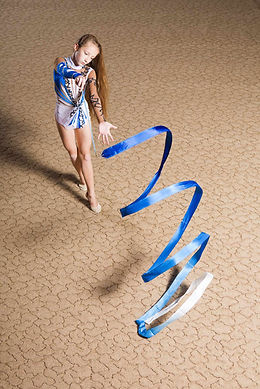Rhythmic Ribbon of Texas
RHYTHMIC GYMNASTICS РИТМИЧЕСКАЯ ГИМНАСТИКА 藝術體操 GIMNASTICĂ RITMICĂ
Rhythmic Gymnastics is...
-
A beautiful, precise Olympic Sport
-
A combination of the dynamics and flexibility
-
The technical knowledge of ballet, and
-
The self-expression and rhythm of modern dance.
Unmatched for its elegant, expressive, precise and graceful movements, Rhythmic Gymnastics is choreographed to music and accompanied by colorful hoops, balls, ropes, ribbons, and clubs.
Rhythmic Gymnastics benefits people, especially girls in their formative years, with …
-
physical fitness
-
self-discipline
-
positive self-esteem
-
lasting friendships
-
team skills
-
fun, and
-
healthy lifestyle that sustains for life!
Rhythmic gymnastics is a sport that combines elements of ballet, gymnastics, dance, and apparatus manipulation. Participants earn points for leaps, balances, pirouettes (pivots), flexibilities, apparatus handling, execution, and artistic effect.
The apparatus includes rope, hoop, ball, clubs, and ribbon. Gymnasts compete with and without apparatus.
The governing body is the Fédération Internationale de Gymnastique (FIG). FIG changed the Code of Points in 2001, 2003, 2005, and 2008 to emphasize technical elements and reduce the subjectivity of judging.
Since 2008, the judging is on a scale of 30 points. Three values add up to be the final points — technical, artistic, and execution. The FIG also selects which apparatus will be used in competitions; only four out of the five possible apparatuses are sanctioned.
International competitions are split between Juniors (for women under sixteen by their year of birth) and Seniors (for women sixteen and over by their year of birth).
The largest events in the sport are the Olympic Games, World Championships, and Grand-Prix Tournaments.



ROPE
The rope may be of a synthetic material which retains the qualities of lightness and suppleness. Fundamental requirements include leaps over the rope and skipping. Other elements include swings, throws, circles, rotations and figures of eight.

HOOP
The hoop is plastic. Fundamental requirements include rotation around the hand or body and rolling. Swings, circles, figures of eight, throws, passes through and over the hoop are other elements which should be included. Because of its size (80 - 90cms in diameter) technical handling is difficult.

BALL
Made of rubber or synthetic material and is 18-20cm in diameter. It should rest in the gymnast's hand and not against the wrist or be able to be grasped. Fundamental elements include throwing, bouncing or rolling. The gymnast must use both hands and work on the whole floor area whilst showing continuous flowing movement.

CLUBS
The clubs are made of synthetic material and characterized by rhythmical tapping. Fundamental elements include mills and small circles, asymmetric movements, throwing and catching. The Clubs must be used in both hands and in one hand. It is one of the more difficult pieces of apparatus to use.

RIBBON
The ribbon is 6 meters in length and probably the most popular event for the spectators. The movements should be large, smooth and flowing. It requires a high degree of co-ordination to form the spiral and circles as any knots which accidentally form in the ribbon are penalized. Fundamental elements include swings, circles, serpents and spirals.